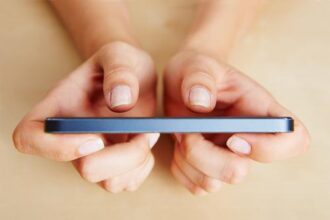- Use of mobile devices is on the rise by healthcare consumers and providers alike.
- Demand for mobile access to healthcare increases as the healthcare ecosystem shifts towards a model where care comes to the patient rather than the patient going to where care can be delivered.
- Supply of mobile healthcare solutions is skyrocketing, with over 13,000 medical and healthcare apps available already, and traditional software-based telehealth solutions adding mobile access to their platforms.
A key part of the mobile healthcare world is the doctor.
This infographic (courtesy of Referral MD and Publicis / Razorfish Healthware) shares how doctors are using mobile technology.
Our selected commentary discusses how to leverage this information to grow a telehealth solution, product, or service.
55% of physicians are using mobile apps
But don’t let the stat fool you into thinking that it’s all clinical. While doctors will use clinical apps such as Epocrates, they are just like other people in that they are common users of apps like Facebook, ESPN, and the Weather Channel.
It’s actually even more critical that doctors are using these devices for socialization, entertainment, and non-clinical information. It means they are comfortable with the devices.
Utilization is a key driver of telehealth adoption.
So if users are at least comfortable with the technology you that enables their telehealth activities, you have a higher chance of the solution being utilized.
Of course, it follows that a bad app on an easy-to-use device is not going to last very long and could easily be replaced if a substitute is available.
So if you’re going to have one of the few apps that the doctor relies on in their daily routine, you must make it user-friendly and clinically sound.
With today’s media-friendly mobile devices, be they smart phones or tablets, doctors find it much easier to access the media that was previously only consumable through their PC’s.
50% of physicians access YouTube for medical purposes.
If you’re not getting information about your telehealth solution up on YouTube, you’re missing a great opportunity to get in front of one of your target users.
YouTube can increase your visibility, can educate your market about your solution, and be more entertaining than a blog for example.
Telehealth and Social Media
Numerous articles have talked about the value of social media in healthcare.
Here is what’s important when you’re targeting physicians – They are engaged in social networks as well.
Some social networks are personal only and some are professional.
Either of those could be useful.
From a marketing perspective, the more opportunities you create for your solution, message, product, or service to be in front of your market, the greater your likelihood of being “top of mind” when they start looking for a solution.
Develop a mobile strategy for your telehealth program, product, or service before you find yourself behind the curve.
Determine how you will engage with physicians (and other clinicians) via mobile devices, video, and social platforms.
This will impact the visibility, strength, utilization, and sustainability of your solution.
How have you used mobile to advance telehealth? Please share your comments.






